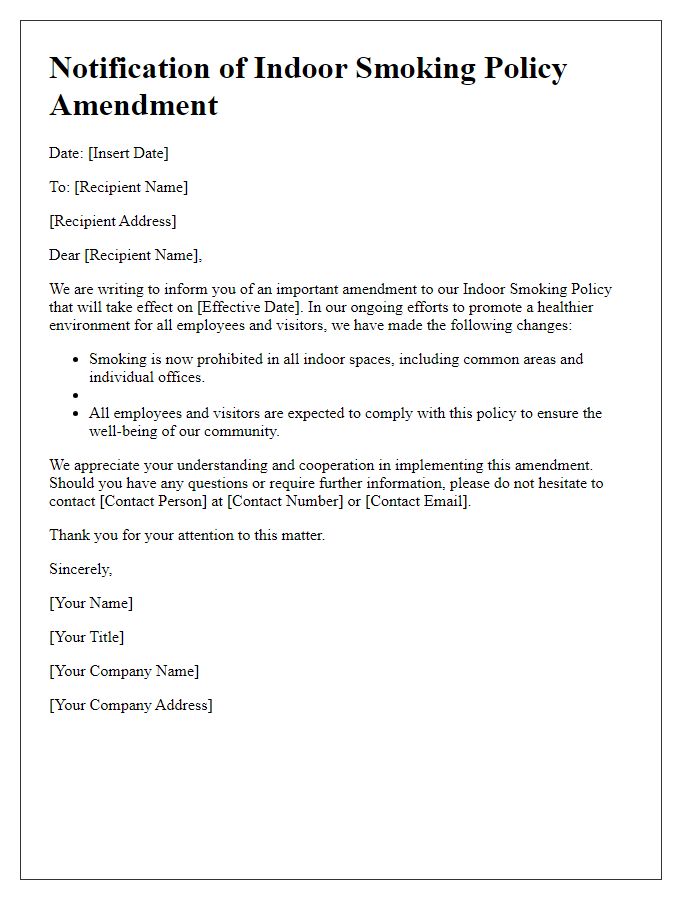Are you a landlord or tenant navigating the complexities of lease agreements in relation to indoor smoking policies? Making changes to your lease can feel overwhelming, but it's essential for promoting health and safety in your rental property. This letter template provides a clear framework to communicate updates regarding indoor smoking rules to your tenants effectively. Dive deeper into the nuances of lease modifications and discover how to craft the perfect notice!

Clear communication of rule changes
Indoor smoking regulations have significant implications for residential leases, particularly in multi-unit buildings such as apartments or condominiums. Effective communication of rule changes is crucial for tenant compliance. The new policy prohibits smoking within individual units and common areas, including hallways and recreational facilities. Violations may lead to penalties, including fines or eviction as outlined in local laws (relevant statutes such as the Clean Indoor Air Act). Tenants must be informed through written notices (minimum 30 days prior to enforcement) detailing the rationale behind the change, health concerns (such as secondhand smoke exposure), and potential impacts on property value. Ensuring clarity in lease agreements helps foster understanding and cooperation among residents, ultimately creating a healthier living environment.
Detailed timeline for implementation
Implementing a new indoor smoking policy in residential leases requires a carefully structured timeline. The process may begin with drafting the policy in January, allowing stakeholders to review and provide feedback. By mid-February, management can finalize the policy document and prepare an announcement for residents, elucidating the reasons for the change and its implications. In March, a community meeting may be scheduled to address concerns and answer questions, fostering transparency. By April, official notices can be distributed alongside updated lease agreements, ensuring residents understand and acknowledge the new guidelines. Moving into May, an implementation date can be set, providing a 30-day grace period for residents to adjust to changes. Throughout June, ongoing communication will be necessary, reinforcing the policy and addressing compliance measures. By July, adherence to the new no-smoking policy should be monitored and enforced, with periodic evaluations scheduled for August to assess its effectiveness and resident satisfaction. This structured timeline ensures smooth implementation of the indoor smoking policy, aligning with best practices in property management.
Explanation of health and safety benefits
Indoor smoking bans in residential leases significantly enhance health and safety standards for tenants. Eliminating smoke exposure reduces the risk of serious health issues, such as respiratory diseases and heart conditions, which are linked to secondhand smoke. Recent studies indicate that nearly 41,000 non-smoking adults in the United States die annually from secondhand smoke-related diseases. Furthermore, properties, including multi-family dwellings like apartments in urban areas, experience lower risks of fire hazards associated with discarded cigarette butts. These regulations contribute to improved air quality within living spaces, fostering safer environments for vulnerable populations, including children and individuals with pre-existing health conditions. Maintaining a smoke-free environment can also elevate property values and attract prospective tenants seeking healthier living conditions.
Contact information for questions or concerns
Indoor smoking policies in residential leases are crucial for occupant health and safety. Properties located in urban areas, such as New York City, often experience increased indoor air pollution due to cigarette smoke, which contains harmful chemicals like tar and carbon monoxide. Recent studies show a rise in respiratory illnesses linked to secondhand smoke exposure, prompting many landlords to revise rental agreements to prohibit smoking inside units. New lease agreements must be clear about designated smoking areas, if any, and outline consequences for violations, fostering a healthier living environment. Tenants should be informed about the importance of these changes and encouraged to voice any questions or concerns to property management.
Acknowledgment of receipt and agreement form
Indoor smoking policies in residential leases have become a critical consideration for many landlords and tenants. Effective date of policy changes should be clearly specified, often including a grace period of 30 days for residents to adjust. The location of the property, such as urban apartments in New York City or suburban homes in Los Angeles, may affect the frequency and intensity of smoking-related issues. Key documents, like the acknowledgment of receipt and agreement form, should detail expectations and consequences for violations, including potential fines or eviction. Tenant expectations for designated smoking areas or ventilation systems may also need to be addressed to ensure clarity and compliance with local regulations.
















Comments